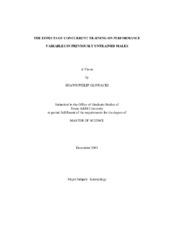| dc.description.abstract | Research has shown conflicting results involving interference of strength development with combined resistance and endurance training. Purpose: To examine if endurance training and resistance training performed concurrently would produce different performance and physiological results when compared to each type of training alone. Methods: Forty-five untrained males were recruited and randomly assigned to one of three 12 wk training groups. An endurance training (ET, N=12) group trained by running (2-3 days/week, 20-40 min, 65- 80% HRR), a resistance training (RT, N=13) group performed a resistance training program (2-3 days/week, 3 sets/8 exercises, 6-10 reps, 75-85% 1RM), and a concurrent training (CT, N=16) group performed both the endurance and resistance training programs (5 days/week, even # week 3 endurance/2 resistance workouts, odd # week 3 resistance/2 endurance workouts). All groups were tested for all the following variables prior to and following training: percent body fat, VO2max, isokinetic-maximal torque and avg. power at two speeds, 1RM leg press, 1 RM bench press, vertical jump, lower body power (as calculated by the Lewis formula) and 40-yard dash time. Results: Percent body fat was significantly (p≤.05) decreased in both the ET and CT groups. Only the ET group significantly improved VO2max (+8.24%). Minimal changes were found for any of the isokinetic measurements. The ET, RT, and CT groups demonstrated significant improvements in leg press (20.4, 40.8, and 39.4%) and bench press (7.5, 30.5 and 21.2%) 1 RM. RT and CT 1 RM improvements were similar and significantly greater than the ET group. Only the RT group significantly increased power. No group showed a significant change in vertical jump or 40-yard dash time. Conclusions: Findings indicate that endurance training does not interfere with strength development, but resistance training appears to hinder development of maximal aerobic capacity. | en |


